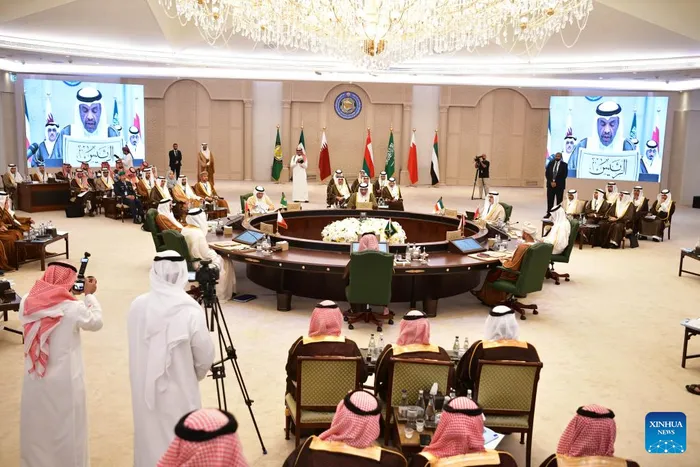BRICS+ Series: Why Gulf Central Banks Follow the Fed’s Cut

This photo taken on June 2, 2025 shows a scene of the 164th session of the Gulf Cooperation Council (GCC) Ministerial Council held in Kuwait City, Kuwait. GCC foreign ministers on Monday called for an immediate ceasefire in the Gaza Strip, backed Syrian sovereignty, and addressed regional security concerns, including Iran's nuclear program.
Image: XINHUA
In the United Arab Emirates, the Central Bank of the UAE (CBUAE) lowered its base rate on the overnight deposit facility by 25 bps to 3.90 per cent, easing from 4.15%. The move takes effect immediately and marks the second rate cut of the year for the UAE.
Similarly, Saudi Arabia’s central bank cut its repo and reverse-repo rates by 25 bps each, landing at 4.50% and 4.00% respectively. Other members of the GCC followed this course: Qatar, Bahrain and Oman also trimmed their rates by 25 bps, while Kuwait chose to hold its policy rate steady, citing alignment with its domestic economic conditions.
Why the linkage is so strong
The central explanation for this synchronicity lies in the fixed-exchange-rate regimes many Gulf states maintain. Five of the GCC currencies including the Saudi riyal, UAE dirham, Bahraini dinar, Qatari riyal and Omani rial are pegged directly to the US dollar. When the Fed adjusts its policy rate, the Gulf central banks face a de facto choice: follow suit or risk destabilising capital flows or undermining the peg’s credibility.
Kuwait’s exception is explained by its slightly different framework: the Kuwaiti dinar is pegged to a basket of currencies, with the US dollar dominant but not sole. That structure gives the Central Bank of Kuwait a bit more flexibility and partly accounts for its decision to hold rates. AGBI
What this means for the region
First, borrowing costs for governments, corporates and consumers will ease. That’s particularly relevant in a region actively pursuing diversification beyond oil, where real-estate projects, tourism infrastructure and manufacturing initiatives require cheaper capital.
Second, the policy move sends a meaningful signal to markets that the Gulf economies remain integrated into global monetary cycles, not just in finance, but in investment expectations and capital-market behaviour. Indeed, previous rate cuts triggered modest uplift in equity markets in the UAE and Saudi Arabia.
Third, by mirroring the Fed’s decision, the Gulf central banks attempt to preserve currency stability, a key pillar for investment and external-sector confidence. As one insight puts it: the fixed exchange-rate commitment “avoids irregular capital movements across borders.”
Beyond the rate cut
The timing of the decisions also intersects with structural transformation agendas in the Gulf. The lowered rates come as many GCC states invest heavily in non-hydrocarbon growth: tourism, manufacturing, logistics and digital infrastructure are all part of the push. The cheaper cost of capital thus helps accelerate that transition.
Moreover, inflationary pressures across the Gulf remain comparatively modest, giving central banks more confidence to ease. For example, the region’s inflation is plausibly forecast to stay around 2 per cent in 2025-26 far less than levels seen in some advanced economies. finews.ch
Risks and caveats
While the policy alignment is clear, certain risks should be borne in mind. The fixed-peg framework, while offering stability, also restricts autonomous monetary-policy responses. Domestic economic conditions may at times diverge from U.S. trends, yet the Gulf central banks have limited room to diverge.
Furthermore, the effectiveness of rate cuts depends on accompanying structural reforms. In environments where diversification, productivity gains and labour-market reform are central to growth, merely lowering rates may not achieve transformative outcomes.
Lastly, the Fed itself has not committed to further cuts; in fact, its chair suggested further easing is “far from a given.” That means the Gulf region may not see a sustained easing cycle unless global patterns align. Reuters
Final word
The recent 25 bps cuts by Gulf central banks reflect more than just convenient timing, they underscore how deeply monetary policy in the region is embedded in global cycles and exchange-rate commitments. For the Gulf states, the move offers welcome financing relief and bolsters their diversification strategies. Yet the underlying fundamentals of reform, investment and structural change remain pivotal. In an era where global capital flows, currency regimes and growth trajectories are tightly linked, the Gulf’s decision to follow the Fed is as much strategic as it is tactical.
Written By:
*Dr Iqbal Survé
Past chairman of the BRICS Business Council and co-chairman of the BRICS Media Forum and the BRNN
*Chloe Maluleke
Associate at BRICS+ Consulting Group
Russian & Middle Eastern Specialist
** MORE ARTICLES ON OUR WEBSITE https://bricscg.com/
** Follow https://x.com/brics_daily on X/Twitter for daily BRICS+ updates
Related Topics: